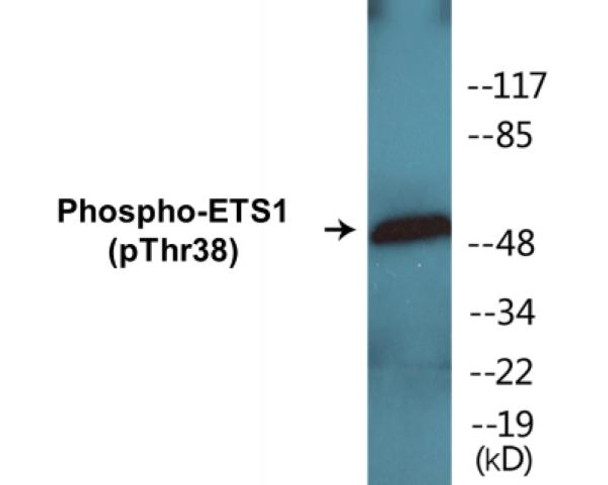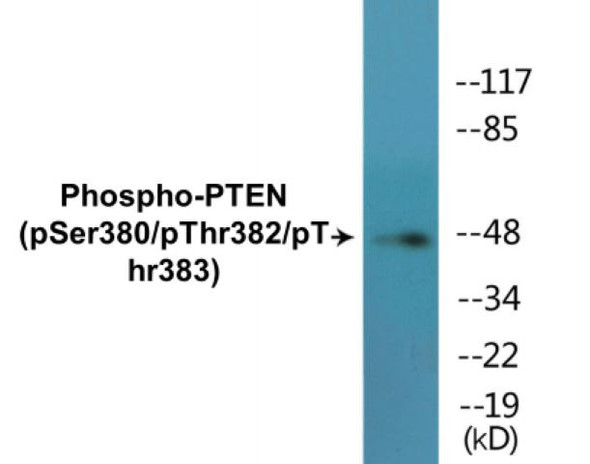Description
ETS1 (Phospho-Thr38)Colorimetric Cell-Based ELISA Kit
The ETS1 Phospho-Thr38 Colorimetric Cell-Based ELISA Kit is specifically designed for the accurate detection of ETS1 phosphorylated at threonine 38 in cell lysates. This kit offers high sensitivity and specificity, ensuring reliable and reproducible results for researchers studying signal transduction pathways and protein phosphorylation events.ETS1 is a transcription factor that plays a critical role in regulating gene expression and cell growth, and its phosphorylation at threonine 38 can modulate its activity and function. By measuring the levels of ETS1 phosphorylated at this specific site, researchers can gain valuable insights into the mechanisms underlying various cellular processes, including cell differentiation, proliferation, and migration.
With its user-friendly protocol and robust performance, the ETS1 Phospho-Thr38 Colorimetric Cell-Based ELISA Kit is an essential tool for investigating the role of ETS1 phosphorylation in physiological and pathological conditions, such as cancer, immune response, and inflammatory diseases. Trust AssayGenie for reliable and accurate results in your research endeavors.
| Product Name: | ETS1 (Phospho-Thr38)Colorimetric Cell-Based ELISA Kit |
| Product Code: | CBCAB00234 |
| ELISA Type: | Cell-Based |
| Target: | ETS1 (Phospho-Thr38) |
| Reactivity: | Human, Mouse, Rat |
| Dynamic Range: | > 5000 Cells |
| Detection Method: | Colorimetric 450 nm |
| Format: | 2 x 96-Well Microplates |
The ETS1 (Phospho-Thr38) Colorimetric Cell-Based ELISA Kit is a convenient, lysate-free, high throughput and sensitive assay kit that can detect ETS1 protein phosphorylation and expression profile in cells. The kit can be used for measuring the relative amounts of phosphorylated ETS1 in cultured cells as well as screening for the effects that various treatments, inhibitors (ie. siRNA or chemicals), or activators have on ETS1 phosphorylation.
Qualitative determination of ETS1 (Phospho-Thr38) concentration is achieved by an indirect ELISA format. In essence, ETS1 (Phospho-Thr38) is captured by ETS1 (Phospho-Thr38)-specific primary antibodies while the HRP-conjugated secondary antibodies bind the Fc region of the primary antibody. Through this binding, the HRP enzyme conjugated to the secondary antibody can catalyze a colorimetric reaction upon substrate addition. Due to the qualitative nature of the Cell-Based ELISA, multiple normalization methods are needed:
| 1. | A monoclonal antibody specific for human GAPDH is included to serve as an internal positive control in normalizing the target absorbance values. |
| 2. | Following the colorimetric measurement of HRP activity via substrate addition, the Crystal Violet whole-cell staining method may be used to determine cell density. After staining, the results can be analysed by normalizing the absorbance values to cell amounts, by which the plating difference can be adjusted. |
| Database Information: | Gene ID: 2113, UniProt ID: P14921, OMIM: 164720, Unigene: Hs.369438 |
| Gene Symbol: | ETS1 |
| Sub Type: | Phospho |
| UniProt Protein Function: | Ets-1: a proto-oncogenic transcription factor homologous to the v-ets erythroblastosis virus oncogene. The DNA binding activity of Ets1 is controlled by kinases and transcription factors. It contributes to the regulation of cellular differentiation in hematopoietic cells. Ets1 promotes invasive behavior in endothelial cells, vascular smooth muscle cells and epithelial cancer cells. Regulates the expression of MMP1, MMP3, MMP9 and uPA as well as of VEGF and VEGFR gene expression. Two alternatively spliced isoforms have been described. |
| UniProt Protein Details: | Protein type:DNA-binding; Motility/polarity/chemotaxis; Oncoprotein; Transcription factor Chromosomal Location of Human Ortholog: 11q23.3 Cellular Component: nucleoplasm; nucleus Molecular Function:DNA binding; identical protein binding; protein binding; transcription factor activity Biological Process: cell motility involved in cell locomotion; immune response; negative regulation of cell proliferation; PML body organization and biogenesis; positive regulation of cell motility; positive regulation of erythrocyte differentiation; positive regulation of inflammatory response; positive regulation of transcription from RNA polymerase II promoter; positive regulation of transcription, DNA-dependent; regulation of angiogenesis |
| NCBI Summary: | This gene encodes a member of the ETS family of transcription factors, which are defined by the presence of a conserved ETS DNA-binding domain that recognizes the core consensus DNA sequence GGAA/T in target genes. These proteins function either as transcriptional activators or repressors of numerous genes, and are involved in stem cell development, cell senescence and death, and tumorigenesis. Alternatively spliced transcript variants encoding different isoforms have been described for this gene.[provided by RefSeq, Jul 2011] |
| UniProt Code: | P14921 |
| NCBI GenInfo Identifier: | 119641 |
| NCBI Gene ID: | 2113 |
| NCBI Accession: | P14921.1 |
| UniProt Secondary Accession: | P14921,Q14278, Q16080, Q6N087, Q96AC5, A9UL17, F5GYX9 |
| UniProt Related Accession: | P14921 |
| Molecular Weight: | 30,860 Da |
| NCBI Full Name: | Protein C-ets-1 |
| NCBI Synonym Full Names: | ETS proto-oncogene 1, transcription factor |
| NCBI Official Symbol: | ETS1 |
| NCBI Official Synonym Symbols: | p54; ETS-1; EWSR2; c-ets-1 |
| NCBI Protein Information: | protein C-ets-1 |
| UniProt Protein Name: | Protein C-ets-1 |
| UniProt Synonym Protein Names: | p54 |
| Protein Family: | Protein |
| UniProt Gene Name: | ETS1 |
| UniProt Entry Name: | ETS1_HUMAN |
| Component | Quantity |
| 96-Well Cell Culture Clear-Bottom Microplate | 2 plates |
| 10X TBS | 24 mL |
| Quenching Buffer | 24 mL |
| Blocking Buffer | 50 mL |
| 15X Wash Buffer | 50 mL |
| Primary Antibody Diluent | 12 mL |
| 100x Anti-Phospho Target Antibody | 60 µL |
| 100x Anti-Target Antibody | 60 µL |
| Anti-GAPDH Antibody | 60 µL |
| HRP-Conjugated Anti-Rabbit IgG Antibody | 12 mL |
| HRP-Conjugated Anti-Mouse IgG Antibody | 12 mL |
| SDS Solution | 12 mL |
| Stop Solution | 24 mL |
| Ready-to-Use Substrate | 12 mL |
| Crystal Violet Solution | 12 mL |
| Adhesive Plate Seals | 2 seals |
The following materials and/or equipment are NOT provided in this kit but are necessary to successfully conduct the experiment:
- Microplate reader able to measure absorbance at 450 nm and/or 595 nm for Crystal Violet Cell Staining (Optional)
- Micropipettes with capability of measuring volumes ranging from 1 µL to 1 ml
- 37% formaldehyde (Sigma Cat# F-8775) or formaldehyde from other sources
- Squirt bottle, manifold dispenser, multichannel pipette reservoir or automated microplate washer
- Graph paper or computer software capable of generating or displaying logarithmic functions
- Absorbent papers or vacuum aspirator
- Test tubes or microfuge tubes capable of storing ≥1 ml
- Poly-L-Lysine (Sigma Cat# P4832 for suspension cells)
- Orbital shaker (optional)
- Deionized or sterile water
*Note: Protocols are specific to each batch/lot. For the correct instructions please follow the protocol included in your kit.
| Step | Procedure |
| 1. | Seed 200 µL of 20,000 adherent cells in culture medium in each well of a 96-well plate. The plates included in the kit are sterile and treated for cell culture. For suspension cells and loosely attached cells, coat the plates with 100 µL of 10 µg/ml Poly-L-Lysine (not included) to each well of a 96-well plate for 30 minutes at 37°C prior to adding cells. |
| 2. | Incubate the cells for overnight at 37°C, 5% CO2. |
| 3. | Treat the cells as desired. |
| 4. | Remove the cell culture medium and rinse with 200 µL of 1x TBS, twice. |
| 5. | Fix the cells by incubating with 100 µL of Fixing Solution for 20 minutes at room temperature. The 4% formaldehyde is used for adherent cells and 8% formaldehyde is used for suspension cells and loosely attached cells. |
| 6. | Remove the Fixing Solution and wash the plate 3 times with 200 µL 1x Wash Buffer for five minutes each time with gentle shaking on the orbital shaker. The plate can be stored at 4°C for a week. |
| 7. | Add 100 µL of Quenching Buffer and incubate for 20 minutes at room temperature. |
| 8. | Wash the plate 3 times with 1x Wash Buffer for 5 minutes each time. |
| 9. | Add 200 µL of Blocking Buffer and incubate for 1 hour at room temperature. |
| 10. | Wash 3 times with 200 µL of 1x Wash Buffer for 5 minutes each time. |
| 11. | Add 50 µL of 1x primary antibodies Anti-ETS1 (Phospho-Thr38) Antibody, Anti-ETS1 Antibody and/or Anti-GAPDH Antibody) to the corresponding wells, cover with Parafilm and incubate for 16 hours (overnight) at 4°C. If the target expression is known to be high, incubate for 2 hours at room temperature. |
| 12. | Wash 3 times with 200 µL of 1x Wash Buffer for 5 minutes each time. |
| 13. | Add 50 µL of 1x secondary antibodies (HRP-Conjugated AntiRabbit IgG Antibody or HRP-Conjugated Anti-Mouse IgG Antibody) to corresponding wells and incubate for 1.5 hours at room temperature. |
| 14. | Wash 3 times with 200 µL of 1x Wash Buffer for 5 minutes each time. |
| 15. | Add 50 µL of Ready-to-Use Substrate to each well and incubate for 30 minutes at room temperature in the dark. |
| 16. | Add 50 µL of Stop Solution to each well and read OD at 450 nm immediately using the microplate reader. |
(Additional Crystal Violet staining may be performed if desired – details of this may be found in the kit technical manual.)







